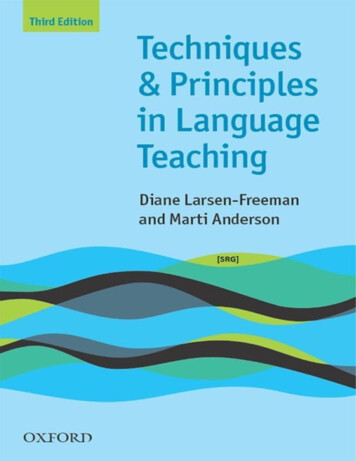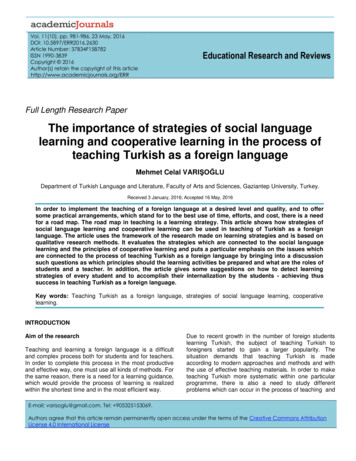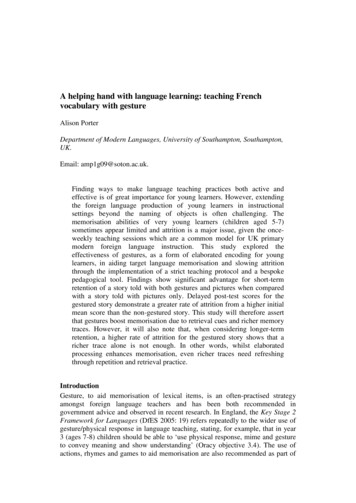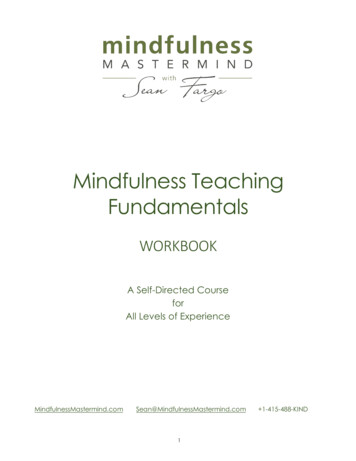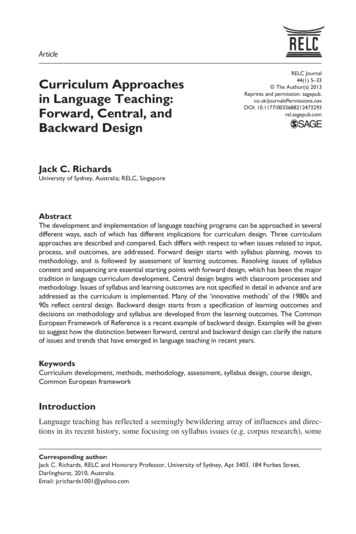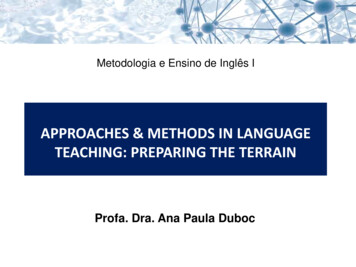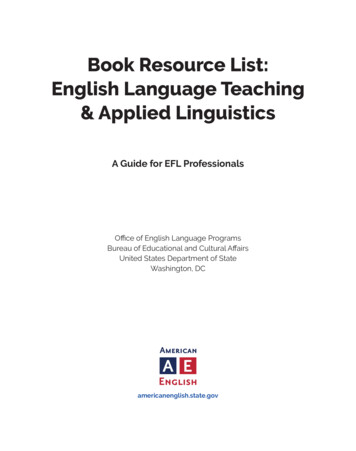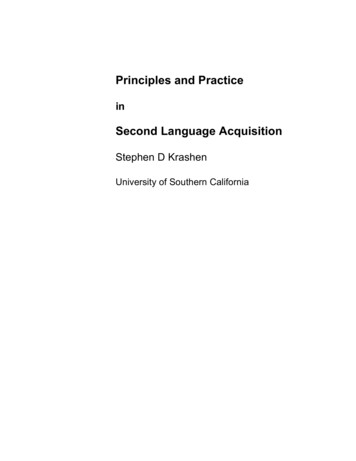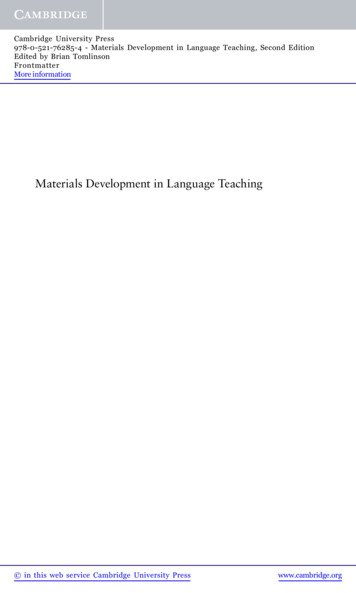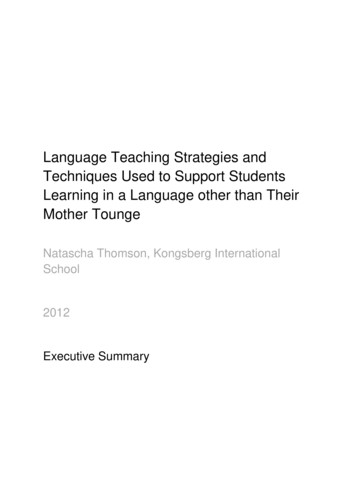
Transcription
Language Teaching Strategies andTechniques Used to Support StudentsLearning in a Language other than TheirMother ToungeNatascha Thomson, Kongsberg InternationalSchool2012Executive Summary
Table of ContentsIntroduction . 3The Research Investigation . 3Overview of Participants and Class Information . 4Data Collection Methods and Procedures . 4The Findings . 6Data Analysis . 11Recommendations. . .14References . . . 152
IntroductionIn today’s global society many learners are facing the challenge of accessing anInternational Baccalaureate (IB) programme in a language other than their mother tongue.To enable learners to fully participate in both the academic and social aspects of school life,educators need to recognize how this phenomenon impacts on teaching and learning andidentify ways to support language development.Learners who are learning in a language other than their mother tongue will often have awealth of knowledge in a language other than that of the classroom. However, thesestudents will often not have been introduced to the vocabulary and concepts of the newlanguage necessary for comprehending content. Cameron (2000:40) comments, “ if theyare not understanding, they cannot be learning.” As it can take up to seven years forlearners who are using a language other than their mother tongue to attain the same levelsof academic language proficiency as those expected for learners learning in a mother tonguethe implications of this in relation to learning are paramount.The Learning in a Language Other than Mother Tongue Document (InternationalBaccalaureate 2008:6) states, “A threshold level of proficiency in cognitive academiclanguage is essential for the learner participation and engagement that is necessary forsubsequent success in an IB programme.” Ways to develop this proficiency seemed to be aquestion of many during a Primary Years Programme (PYP) workshop that the researcherattended. The issue of how to teach the PYP to children who did not speak English or thelanguage of instruction was a common problem identified by many. Based on this issue aresearch investigation with the aim of raising teacher awareness of the strategies andtechniques that could be used to support the language development of young learners wasconducted.The Research InvestigationIn 2010, a research project funded by a grant from the Jeff Thompson Award, wasconducted to identify ways in which language support could be provided when teaching aUnit of Inquiry in the Primary Years Programme to children who did not speak English or thelanguage of instruction. The objectives of this research investigation were as follows:1. To observe, record and analyse the strategies and techniques PYP teachers use toimplement their unit of inquiry to children learning English as a foreign language oradditional language.2. To create a resource bank of language teaching strategies, ideas and techniques forteachers to use when implementing units of inquiry.3. To help raise teacher awareness of language learning through the programme ofinquiry.3
Overview of Participants and Class InformationTen teachers, nine working in the European region and one in the Pacific region volunteeredto participate as case studies for this research investigation. All participants worked inschools which were implementing the Primary Years Programme and the language ofinstruction at each school was English.TeacherGenderAgeRangeNumberof YearsTeachingLanguageTeacherTrainingEnglishas a FirstLanguageNumberofStudentsin htTeacherNineTeacherTenNumberof GirlsinClass7Number ofNationalitiesin classNumber ofLanguagesSpoken byStudents13Numberof 7512831-408NoYes151141010Male61 sYes191181211Data Collection Methods and ProceduresFor this research investigation the term strategies was defined as, “ the approaches thatcan be used across curricular areas to support the learning of students” (Herrell and Jordan2004:5) which “ may be used only on occasion” (Ritchhart, Church and Morrison 2011:48).While techniques was defined as “The body of specialized procedures and methods used inany specific field” (Dictionary.com). However, due to the difficulty in establishing anddistinguishing between the two during one lesson observation the researcher decided tomake the two terms interchangeable.The tools used to collect information were lesson observations, teacher interviews, PYP Coordinator interviews and field notes.Observations of Unit of Inquiry lessons were selected as a tool for data collection in order togain insights and practical ideas of how teachers were providing language support anddeveloping student’s language skills in the classroom when teaching. An audio recording of4
the lesson was made during the observation and used to make a transcription. Thistranscription enabled the researcher to tally the strategies and techniques that eachparticipant used during the lesson observation.The following three questions were designed to provide a focus for lesson observations andhelp with the development of lesson observation tools.-What types of language are teachers using to help students negotiate meaning andunderstand their environment?-How are teachers modeling language and helping young learners to acquire thetarget language?-How are teachers making learning experiences meaningful and comprehensible forchildren in the classroom?Teacher interviews were used to encourage teachers to reflect on their beliefs and languageteaching practices. Participant’s perceptions of how language should be taught and howlanguages are learned were also of interest to the researcher. It was hoped that these mightprovide the researcher with a possible understanding of the reasons for different languageand activity choices made by a teacher (Wallace 1998).Field notes pertaining to the classroom and school environments were used to recordtechniques, strategies and ideas that schools were using to support English languagelearners in the PYP programme.The PYP Co-ordinator interview was designed to enable the researcher to build a profile ofthe school and to facilitate a discussion on the strategies and policies the school was usingto support English language learners. Stake (2006:23) comments, “An important reason fordoing the multicase study is to examine how the programme or phenomenon performs indifferent environments”.The researcher felt it was important to use a variety of means to collect information about theteacher and school to help create a more in-depth view of each school’s programme.Although all participants worked in schools which were implementing the Primary YearsProgramme and the language of instruction at each school was English, variables of thiswere examined to see if they impacted on the types of language used by a teacher or thestrategies and that they employed.The variables considered included the language learning and training experiences of eachparticipant, participant’s language teaching and learning beliefs, the types of interaction thatoccurred during the observation between the teacher and students and finally the languagelevels of learners in the classes participants taught.5
The FindingsThe following graph illustrates the overall way in which language was used during the lessonobservation by all participants.Fig 3.1: Overall Types of Language Used During LessonObservationsUnclassifiable0%Error correction0%Response to andrepetition of studentanswers20%Instructions18%Closed questions15%Think alouds2%Praise5%Eliciting3%Pause3%Prompt and probe4%Discipline andcontrol4%Asking guage11%During lesson observations all ten participants were seen to be using the following types oflanguage asking open and closed questions, responding to and repeating student answers,giving instructions, using activity related language and directing specific questions toindividuals.Asking Open and Closed QuestionsClosed questions accounted for 15% of language use during the observed lessons and openquestions 8%. These results appear to be in line with research which has shown that closedquestions tend to be used more frequently than open questions (Nunan 2000). Closedquestions appeared to be used during lessons to identify what students knew and wereusually asked in a quick and successive manner. It would also seem that these questionswere used when the teacher had a particular idea or answer that they wanted the students tocome up with.Open questions were often displayed in the classroom and related to the unit of inquiry. Indiscussion they were often used to discuss the unit of inquiry students were working on. Theuse of open and closed questions during a lesson may have provided participants with aninsight into what individuals in their class knew and could have helped to activate individual’sprior understanding and knowledge of a particular concept. Cameron (2001:4) comments“ the child is an active learner and thinker, constructing his or her own knowledge from6
working with objects or ideas.” This knowledge may be organized into a schema (Fisher2005) a conceptual framework that continually modifies and grows according to the ways inwhich a learner construes and personalizes information based on previous experiences(Bennett and Dune 1994). Determining what an individual knows may therefore have helpedparticipants to develop the schemas of their learners which can be partially formed,incomplete, unclear or inaccurate (Bennett and Dunne 1994).Participants also used questions to check if students knew what they were expected to doand asked students to re-tell instructions to a partner to help reinforce their instructions andwhat learners had been asked to do. Language learners “ actively try to make sense, i.e. tofind and construct a meaning and purpose for what adults say to them and ask them to do”(Cameron 2001:19). Checking the comprehension of instructions would appear to be animportant strategy to use in the classroom and may provide the teacher with an indication ofhow much learners have recalled from discussion, instruction or previous lessons.Asking a Specific StudentAsking individual students specific questions accounted for 7% of language use. Usingquestions to encourage a more in-depth response from a student may be “ a way ofextending dialogue with children” (Fisher 2005:26). Rather than accepting short answers, wesupport learning if more extended answers are sought. Therefore, directly asking anindividual a question may be a useful technique to employ when wishing to help develop anindividual student’s language skills. It might also be useful in teacher-fronted interactions tohelp distribute response opportunities widely to ensure that all learners are kept alert andgiven an opportunity to respond (Nunan 2000).Response To and Repetition of Student AnswersThe category of Response to and Repetition of Student Answers amounted to a total of 20%of participants language use during lesson observations. The types of responses to studentanswers that participants used varied from one word responses such as yes, yeah and okay,to instances where the participant would repeat a student’s answer to reinforce a keyconcept or point. On occasion a student would provide a teacher with a one or two wordanswer. A teacher would respond to this by providing a full sentence with the student’sanswer incorporated.Giving InstructionsGiving instructions accounted for 18% of language use during lesson observations.Instructions were observed to be given for a variety of purposes such as for a teacher tostate their intentions, to prepare students for an activity, to organize students into groups orpairs and as part of the management of the class.Activity Related Language11% of teachers language use was activity related language. This type of language use wasfelt to be of great importance by several participants as they believed it helped students tomake meaningful connections and enabled them to learn about the language through thelanguage. Nunan (2000:189) adds, “Teacher talk is of crucial importance for the processesof acquisition because it is probably the major source of comprehensible target language7
input a learner is likely to receive”. Using this type of language may provide students with atype of scaffolding, which is essentially a way to nudge a student toward higher levelperformance and may help them reach the goal of being an autonomous learner. As everyindividual interprets a learning experience in a way that is meaningful to them (Williams andBurden 1997), students may need support in finding ways of constructing links andcommunicating their understanding and experiences to others (Bennett and Dunne 1994).“Learning to do things and learning to think are both helped by interacting with an adult”(Cameron 2002:7). “With language development, this can be done by modeling correctgrammar or pronunciation, asking challenging questions, or providing direct instruction” (Hilland Flynn 2006:16).Language Teaching Strategies and TechniquesIn addition to identifying the types of language that participants used, the researcher wasalso interested in the specific language teaching strategies and techniques that were beingused during a lesson. The following graph illustrates the overall strategies and techniquesthat participants were observed using, by the researcher, during the lesson observation.Fig 3.2: Language Teaching Strategies and Techniquesused During Lesson ObservationRepeat afterme0%Drilling0%Pre-teaching language0%Re-castsStudent5%thinkingtime6%Error correction1%Lead in statements7%Vocabulary checks21%Eliciting20%Translation0%Modelling of activities8%Think alouds13%Modelling oftarget language19%Vocabulary ChecksAt 21%, the language teaching strategy of vocabulary checks was used the most byteachers and in several different ways. One participant predicted that the students in herclass would not know what a particular word meant which was crucial to the studentsunderstanding a story. The teacher chose to show the class a picture of the word. This is astrategy that might have helped to make the word easier for students to understand and8
remember (Bloor 1991). Vygotsky (1978) adds that for young learners in the early stages ofdevelopment there is a close bond between what they see and meaning.Several teachers took time during lessons to check that students had understood themeaning of key words or concepts. This strategy may have enabled individuals to connectnew vocabulary with words that they already knew in their first language (Brewster, Ellis andGirard 2004). Participants often used questions to check that students had understood themeaning of key words or concepts. Brewster, Ellis and Girard (2004:81) suggest that,“Providing examples of words, their meanings and demonstrating how they might be usedwhen beginning to learn a language may be more important than attention to thegrammatical components and spelling of vocabulary” (Brewster, Ellis and Girard 2004:81). Itmay also be of importance to note that, “The acquisition of word meanings takes muchlonger than the acquisition of the spoken form of the words, and children use words in theirspeech long before they have full understanding of them” (Cameron 2001:73).Another strategy teachers used to check vocabulary understanding was to review andrecycle previously discussed vocabulary associated with the Unit of Inquiry or from priorlessons at the beginning of a lesson. This may have provided learners with the opportunity tore-hear words and possibly helped with the retention of these words in their long-termmemory. Brewster, Ellis and Girard (2002:63) add “Children constantly need to recycle whatthey have learned so they don’t forget, and to perceive progress, maintain motivation and aidmemorisation”.ElicitingEliciting was a technique that was used a total of 20% in lesson observations. This strategyhelps a teacher to bring forward student’s ideas and extend and sustain discussion whichFisher (2005) considers to be an important function of a teacher. Conversations that extendpast a single exchange may help a learner’s language development as it could provide amore realistic model of how an authentic conversation occurs (Wells 1986). This kind ofdiscussion might also help to reveal to a teacher “. the framework the children are using tointerpret new information” (Wells 1986:115) and might possibly provide children with some ofthe language and ideas they will need to complete subsequent activities.Modeling of Target LanguageThe modeling of target language was a strategy that accounted for 19% of the strategies andtechniques used during lesson observations. Hill and Flynn (2006:23) suggest that,“Language structure and form should be learned in authentic contexts rather than throughcontrived drills in language workbooks”. The modeling of target language would seemtherefore to be an extremely important strategy for teachers to use, as these models may bea student’s only guide on how the additional language is used in a natural environment.Think AloudsThink alouds were a strategy and technique that were noticed a total of 13% of the timeduring lesson observations. A think aloud can be defined as the offering of a teacher’s innerdialogue or opinions out loud for students to hear their thoughts, ideas and to model selfregulation of the thinking process possibly through questions such as; “What am I going todo now?”, “What is my problem?”, “I wonder what would happen if ” . Fisher (2005:47)9
suggests that the strategy of thinking aloud provides teachers the opportunity “ to modelthe world as we understand it in words”. The use of such a strategy may enable learners tohear more authentic and broader examples of the target language (Nunan 1991) andpossibly help to scaffold and develop their own thinking skills (Fisher 2005).Modeling of ActivitiesThe modeling of activities accounted for 8% of the strategies and techniques used duringlesson observations. Dőrnyei (2001:58) comments that the criteria for the successfulcompletion of an activity need to be explicitly clear to all learners although for some adiscussion about these will not be enough. The use of live demonstrations and thepresentation of examples of other student’s work may provide a more complete descriptionof the standard of content and presentation that is expected for a particular activity andpossibly help to ease learner anxiety caused by not knowing what to do (Cameron 2001).Student Thinking TimeStudent thinking time totaled 6% of observation time. This strategy was employed byparticipants after they had asked a question. Students need to be provided with theopportunity “ to think about questions after they have been asked before attempting toanswer them” (Nunan 2000:193). In a research investigation it was shown that by extendingthinking time from three to five seconds after asking a question there was a rise in studentparticipation (Nunan 2000:193) and a significant increase in the quality of student answers(Fisher 2005:23). It would seem therefore by consciously allowing silence after asking aquestion a teacher may be fostering an environment more conducive to thoughtfulresponses and allowing language learners more time to connect to what has been asked.Re-castsRecasts were a strategy observed to be used a total of 5% of all strategies and techniques.A recast, that is, the repetition of a student’s utterance making changes to convert it to acorrect phrase or sentence (Lightbrown and Spada 2006) may provide a teacher with theopportunity to model how a sentence or phrase should be used without having to obviouslyhighlight the student’s error.For example:18:44 Student EightThe trees are cutting down and ah, for another house.18:47 Teacher FourtheyExcellent, Student Eight. They’re cutting down the trees andare going to build a new house.“As no two students who are learning a language will have the same amount of grounding intheir native language, or are at the same stage of English language acquisition” (Flynn andHill 2006:3) it would seem that this type of modeling of language is therefore of greatimportance.Error CorrectionAt 1%, error correction was the least frequently used language strategy during the observedlessons. Hill and Flynn (2006:32) suggest that, “The best way to provide corrective feedback10
when grammar or pronunciation errors are made is simply to model the correct Englishwithout overtly calling attention to the error”. Lightbown and Spada (2006:190) add that thiscorrective feedback should also be provided in a clear and precise way e.g.23.04 Student TwoI did choose caring.23.06 Teacher OnePardon, pardon?23.08 Student TwoI did caring either.23.09 Teacher OneYou did caring as well.23.11 Student TwoAh ha.It is important to note that this type of correction might only be beneficial if a student is at thatcurrent level in their grammatical development; a child who is not, is unlikely to automaticallyuse the correct form (Lightbown and Spada 2006:190). Nunan (2000:198) also suggeststeachers “.need to monitor not only how and when such feedback is provided, but alsowhether the feedback is positive or negative, and who receives the feedback”.Incorporating Small Group and Pair Work in LessonsDuring lessons students were often given opportunities to work in small groups and with apartner which according to Hill and Flynn (2006:55) may be “ a powerful tool for fosteringlanguage acquisition”. “Research has shown that learners use considerably more language,and exploit a greater range of language functions when working in small groups” (Nunan2000:51). Small groups also enable participants to hear language from each other thereforea different source of input from the teacher. This might help to make students feel morecomfortable and relaxed and possibly reduce the anxiety related to attempting the targetlanguage (Hill and Flynn 2006).Elaborated InputDuring lessons, some teachers used Elaborated Input, that is the use of “ repetition,paraphrasing, slower speech contains redundant information, the redundancy beingachieved through repetition, paraphrase, slower speech and so on” (Nunan 2000:191) andaccording to research may be more effective than a teacher using simpler syntax andvocabulary (Nunan 2000:191). The use of this type language with actions, illustrations,context or prior knowledge, is a key factor in helping children to learn a second language(Brewster, Ellis and Girard 2002).Data AnalysisWhat types of language are teachers of the same class level using?Overall, it did not appear that teachers of a particular class level used different types oflanguage more than other teachers teaching a different class level. Both the teachers of theclasses of ten to twelve year olds used the same types of language in exactly the sameorder. However, two teachers of the six to eight year old classes also used these types oflanguage. All teachers had the language type of response to and repetition of student11
answers, in their four most frequently used types of language during the observation. Thelanguage type categories of instructions and closed questions featured in nine out of tenteachers most frequently used language types. Six out of ten teachers used the same fourlanguage types in varying orders of frequency, during their lessons. These types of languagewere response to and repetition of student answers, instructions, closed questions and ontask discussion.Do teachers of a particular class level use more strategies or techniques thananother?Teachers in the Lower Primary used more Modeling of target language, Recasts, ErrorCorrection, Think alouds, Modeling of activities and Vocabulary checks and definitions thanteachers in the Middle and Upper Primary. In the Middle Primary teachers used higher levelsof Eliciting and Student thinking time. The Upper Primary group was not seen to use anystrategies and techniques more than the Lower and Middle Primary Groups. However, thenumber of teachers in each group needs to be considered as a factor for this. The UpperPrimary group consists of only two teachers where as the Lower and Middle Primary groupseach have four teachers.It would seem that the strategies and the techniques that the Lower Primary group usedmore frequently than the Middle and Upper Primary groups are more suited to catering forthe developmental and linguistic needs of students of the six to eight year age. While thetype of lesson occurring during lesson observations may help to account for slightly higheruse of the strategy Eliciting by the Middle Primary group which saw teachers trying toestablish what students understanding of a particular concept or topic was.The greatest difference of strategy and technique use between the three class level groupswas in the category of Modeling of target language, where the lower primary’s average usewas 18 instances, while the middle and upper primary instances were 2 and 3 respectively.The gap in this figure can be explained by a large number of instances in one participant’slesson where this strategy was used in a phonics lesson. During this lesson the teacherrepeated several sounds and words with the focus sounds in order to reinforce student’sknowledge of these particular sounds. The instances where the teacher modeled targetlanguage in this lesson amounted to 54 which greatly distorted the overall figures.Possible Factors for Specific Types of Language Use and Choice of Strategy andTechniques Employed By TeachersThe level of language learners, whether participants had participated in any languageteacher training, the types of interactions during the lesson between the teacher andstudents and teacher beliefs were all considered as possible reasons why teachers might bechoosing to employ a particular type of language or strategy and technique.The level of language learners was presented as a possible factor for consideration asdifferent types of language and strategies/techniques may be more useful for learners atvarious times of their language learning development. It was found that some connectionsbetween language use and the level of language of students in a class could be made butwhether this was deliberate and planned for, by the teacher, was very difficult to determineand examine therefore making this a tenuous link.12
The types of language teacher training participants have had was the next factor to beanalyzed. Five participants of the ten identified themselves as having had language teachingtraining. However, all participants showed they made some accommodation for languagelearners in their lessons by the language they used and the strategies/techniques theydemonstrated during the observation. Overall, the differences between those with languageteacher training and those without were not as marked as the researcher had predicted theywould be. It was suggested that this might be attributed to the types of professionaldevelopment that those teachers with language teaching undertook and whether or not thiswas a sustained learning experience with professional support and follow up or if this was aone off course. Research (Meiers and Buckley 2010) has shown that the former is morelikely to lead to greater improvements in student learning and teaching skill. One possiblereason for the similarities between the two group’s use of language and strategies andtechniques may be that all of the participants were working in the PYP in an InternationalBaccalaureate authorized school and had completed the initial IB Making the PYP HappenWorkshop at the time of their lesson observation. In addition to the Making the PYP Happenworkshop each participant on average had completed another two workshops run by the IB.These workshops may have helped to standardize participants’ understandings of the PYP.However, not all participants had completed the language based workshops offered by theIB perhaps due to the category level of these workshops and that the aim of one workshop isto create a language policy.The types of talk that took place between teachers and students was also investigated tosee if there was any correlation between this and the types of language and the strategiesand techniques used during their lessons. Some lessons observed demonstrated a moreteacher centred approach while others a more learner centred approach. Lessons at thebeginning of a Unit of Inquiry often involved the teacher front loading information and weretherefore more teacher centred while those lessons that were observed towards the end ofthe unit involved students working independently on inquiry and were more learner centred.The context of the school might also determine whether a lesson is more teacher centredand may be a requirement of the particular setting they are working in. Overall a highnumber of learner centred lessons were observed which would appear to be in line with thephilosophy of the PYP that teachers should be facilitators of learning. It was concluded thatlanguage learners need to be exposed to different types of language and working withstudents in different ways such as whole class, pair and group or individually provides
implement their unit of inquiry to children learning English as a foreign language or additional language. 2. To create a resource bank of language teaching strategies, ideas and techniques for teachers to use when implementing units of inquiry. 3. To help raise teacher awareness of lan
